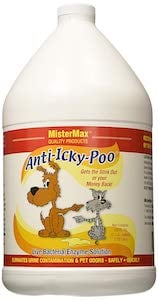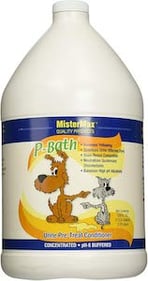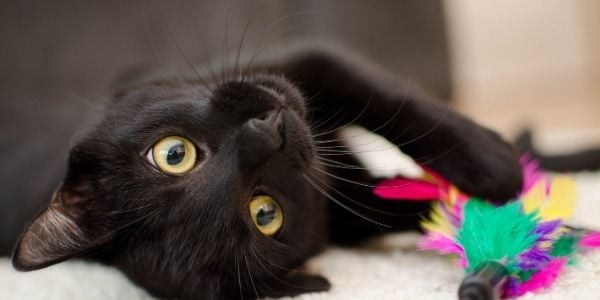 Does it ever seem like your cat has an accident in one spot and keeps returning to the same spot? Well, here's a fun fact: this isn’t their favorite spot to pee or poop.
Does it ever seem like your cat has an accident in one spot and keeps returning to the same spot? Well, here's a fun fact: this isn’t their favorite spot to pee or poop.
More likely than not, you didn’t clean up the last mess all the way, which is why they keep returning to the scene — or, more accurately, the scent — of the crime.
Cats (and dogs) follow their nose when it comes to their stinky, messy business. If they have an accident outside of their litter box, they’ll keep going to the same spot even after it’s (supposedly) cleaned up.
Just because you think the mess is gone doesn’t mean it’s really gone. Odors that are undetectable to your nose are like a magnet to a cat’s nose, causing them to come back again and again until the area has been thoroughly cleaned. After all… the nose knows! Especially when that nose belongs to a cat (or a dog).
The following 4-step cleaning process will work on hardwood, linoleum, and carpet, though rugs and carpeting can require a little extra special attention to clean. (You can also skip to the section on rugs and carpets to learn more.)
Whatever You Do, Don't Steam Clean Urine Stains First!
You need to neutralize the odor with the enzymatic and bio-based cleaners first. Otherwise, the steam can "set" the stain and odor by permanently bonding the proteins contained in the urine (or poop) to the fibers of your carpet. That "set" stain and odor will now be a permanent reminder to your cat that they "were there," which will likely tempt them to go there again (and again and again... ).
Dr. Marci Koski of Feline Behavior Solutions has tried a lot of different products over the years, and so far, she's found the best results with Mr. Max P-Bath as the neutralizer and Anti-Icky Poo as the enzymatic cleaner.
How to clean kitty messes to keep them from happening again
1. Suit Up
Before you start cleaning, make sure to wear gloves in order to protect yourself from potential urine and fecal pathogens, like the Leptospirosis bacteria that can be in cat pee or the Giardia or Toxoplasmosis parasites that can be in cat poop.
2. Remove the Mess
First, remove the bulk of the mess with paper towels. Use dry paper towels to remove the poop or soak up the urine, then follow up with towels soaked in warm water to wipe away the rest of the smaller residue.
3. Get a Good Pee and Poop Cleaner for Cats
Don’t reach for the bleach or other common household cleaners. Instead, grab a good enzymatic cleaner that is manufactured specifically to neutralize the odor from cat pee and poop. Most quality enzymatic or bio-based cleaners will do, but we prefer the Unique Natural Products Pet Odor and Stain Eliminator.
4. Double Check – Use Blacklight to Spot Urine
If your cat continues to go to the same spot, you’ll know you didn’t completely neutralize the smell. But it’s not all bad news — now you get to unleash your inner CSI skills. Try using a blacklight to check for residual or old stains so you can go over them again with your cleaner. Even when you think you've cleaned a spot well, there can be residual proteins and smells that your cat will find.
This UV flashlight is less expensive; however, the wavelength from this UV Blacklight Torch (365–370nm) is more effective — but it's a pricey gadget. (FYI: The greater the wavelength, the better visibility for fluorescing proteins in urine.) Both of these lights will work, but the less expensive light will typically only work in a very dark room.
A Note About Rugs and Carpets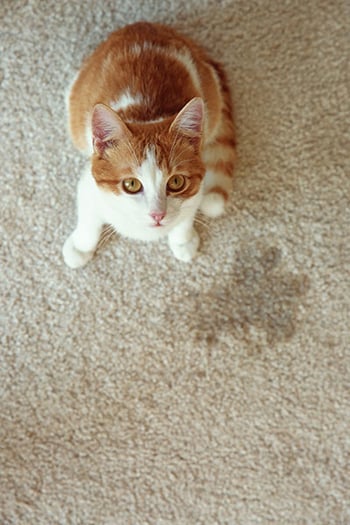
Doesn't it feel like cats specifically seek out the one piece of rug or carpeted area in a home instead of other easier-to-clean surfaces? Sure, it’s more difficult and a little yuckier to clean pee and poop out of your carpet than, for instance, linoleum or hardwood, but you can still address the whole mess with a few extra steps.
- Remove the bulk of the mess — either by soaking up the majority of urine or removing poop with paper towels — and cover the area with a healthy supply of paper towels.
- Press the towels into the area (this is where gloves are especially “handy”) and leave them for a few minutes to soak up as much of the liquid as possible. Putting a plastic bag over your shoe/slipper and standing on the towels will help draw out as much liquid as possible, too.
- Hit the spot with your enzymatic cleaner or preferably with a foaming carpet-specific cleaner like Nature's Miracle Advanced Stain and Odor Eliminator Foam. Work the cleaner into the material and leave it for a few minutes to do its work.
- Finally, use paper towels or hand towels soaked in warm water to scrub the area, then dab with dry paper towels.
- Check with your blacklight to make sure you’ve successfully cleaned the area.
One Final Piece of ‘Business’
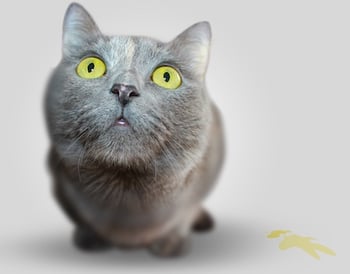 Whether you’re cleaning an accident from a hard surface or carpeting, the key is to remove the mess as quickly as possible. The sooner you catch an accident and clean it, the easier it will be to neutralize the odors that keep your cat coming back.
Whether you’re cleaning an accident from a hard surface or carpeting, the key is to remove the mess as quickly as possible. The sooner you catch an accident and clean it, the easier it will be to neutralize the odors that keep your cat coming back.
If your cat is having lots of accidents, there’s a good chance their litter box is the wrong size, not cleaned frequently enough, or there aren’t enough boxes for your cat(s).
Find out why your cat might be “going” outside of their box — and a few simple ways to curb that stinky litter box odor.
In some cases, frequent accidents might also be a warning sign for a medical issue like bladder inflammation, urinary tract infection, arthritis, diabetes, and others.
Learn more about why your cat is eliminating outside of the litter box and for some great solutions for getting them to stop, tune in to our podcast episode with Dr. Marci Koski, from Feline Behavior Solutions!


